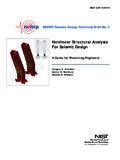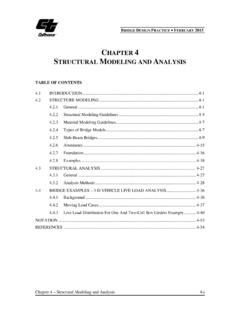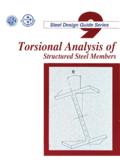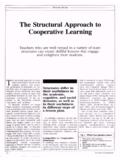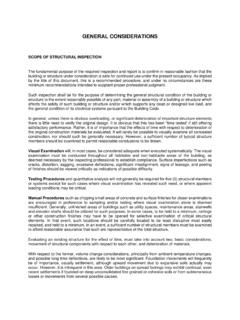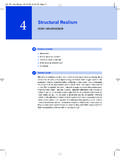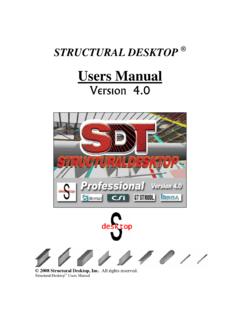Transcription of Structural Integrity Analysis - kokch.kts.ru
1 Structural Integrity Analysis 1. stress Concentration Copyrighted materials 1 Structural Integrity Analysis 1. stress CONCENTRATION Igor Kokcharov STRESSES AND CONCENTRATORS stress An applied external force F causes inner forces in the carrying structure. Inner forces F' are shown by the blue lines spread throughout the structure. Inner forces are distributed differently in each part of the structure. To describe the inner forces in a section of the structure we use stress defined as the force divided by the cross-sectional area. stress corresponds to the force acting on a unit of area (square millimeter, square inch, square meter, etc.)
2 A smaller cross-sectional area creates a larger amount of stress under the same external force. Structural Integrity Analysis 1. stress Concentration Copyrighted materials 2 As a result, compressive and shear forces also cause compressive and shear stresses. As a rule in complex structures, tensile stress results in compressive stress in the perpendicular direction. Strain The shape of a structure will change under loading. For example, a structure will elongate under tension. To estimate this process the value of the strain was introduced. Strain is the ratio of elongation to initial length and is therefore dimensionless.
3 It is also linearly proportional to stress . Structural Integrity Analysis 1. stress Concentration Copyrighted materials 3 Concentrators When inner forces go around holes or notches, they will concentrate near such obstacles. stress concentrators are areas that tend to magnify the stress level within a part. stress that is higher in one area than it is in surrounding regions can cause the part to fail. If the radius of curvature in the notch tip is very small or if there is no radius (crack), the stress level is very high. Sharp corners are especially critical. What can serve as stress concentrators? - Holes and slots - Notches or grooves - Ribs, gussets, and posts - Sharp wall thickness transitions - Surface roughness - Bosses - Corners The mentioned design features will not cause stress concentration in those parts where there are no inner forces (stresses).
4 Structural Integrity Analysis 1. stress Concentration Copyrighted materials 4 FORCE LINES Force lines show forces inside a structure. They have dimensions (units) of external force. If external force 10 N is shown by five force lines, each line has its "price" that is equal to 10 / 5 = 2 N. Usually, all force lines have a constant price in one figure. For any state of stress , it is possible to determine the direction of the maximum tensile stress . This stress is called the main stress . Force lines are drawn by the integration of the main stresses. Mathematical methods are used to draw force lines. We use a few simple rules to present force lines: Force lines start on the surfaces where the external forces are applied.
5 They go around "obstacles" such as holes and notches. Structural Integrity Analysis 1. stress Concentration Copyrighted materials 5 Force lines are distributed uniformly for tension. Their density is higher at the edge of a beam under bending. By passing around the "obstacles," the force lines concentrate in the tip (a). They are not uniformly distributed near the concentrator (b). There is no sudden change of direction (c). Force lines cannot intersect each other (d). Structural Integrity Analysis 1. stress Concentration Copyrighted materials 6 Both tensile and compressive force lines can be used in the Analysis .
6 Usually, compressive lines are perpendicular to tensile lines. Force lines will compensate for each other under bending. Structural Integrity Analysis 1. stress Concentration Copyrighted materials 7 stress CONCENTRATION FACTOR stress concentrators cause high stresses in the structure. The stress concentration factor is the ratio of maximum stress to nominal stress . It is greater than 1 and a dimensionless parameter. There are different formulas for nominal stress , which usually occurs in the absence of concentrators. The authors of the theory of elasticity proved that tensile stress near a hole in a wide plate is three times higher than nominal stress .
7 This means that the stress concentration factor is equal to 3 in this case. Structural Integrity Analysis 1. stress Concentration Copyrighted materials 8 The stress concentration factor increases depending on: a) The larger size of the obstacle on force line path a b) The smaller size of the obstacle along force line path b c) The smaller radius of curvature in the notch tip Theoretically, if the radius tends towards 0 (sharp crack), the stress concentration factor tends towards infinity. That conclusion is correct only for an ideal elastic body. In real structures, the stress concentration factor is finite due to plasticity and microstructural changes.
8 Thus, the stress concentration factor increases as the radius of curvature in the notch tip decreases. Structural Integrity Analysis 1. stress Concentration Copyrighted materials 9 A larger radius in the notch tip will lower the stress concentration. THEORY OF ELASTICITY AND stress CONCENTRATION At the beginning of the 19th century, the authors of the theory of elasticity showed that an elastic body with a hole will change its form by extending in one direction and compressing in another. A round hole is converted into an elliptical one with a larger axis along the tensile direction. Structural Integrity Analysis 1.
9 stress Concentration Copyrighted materials 10 Usually, nominal stress is defined as the average stress in a cross-section. Consider the three situations to the right. In the last case, the stress is very high due to the large amount of nominal stress . The stress concentration for the third scheme is lower. Elliptical holes can be problematic if the larger axis is perpendicular to the applied tension. In this case, the width of the "obstacles" on the force line path is large and the radius of curvature in the notch tip is small. Structural Integrity Analysis 1. stress Concentration Copyrighted materials 11 The formula shown here is valid for an elliptical hole in an infinite plate.
10 Only in theory does the stress concentration factor tend towards infinity for a crack (radius of curvature is equal to 0). Two holes lying along the same axis of tension have a stress concentration lower than 1, while two holes on the same "obstacle" on the force lines path act as the elliptical hole. MIXED MODE stress CONCENTRATION In the notch, the stress is as high for tension as it is for shear. The stress concentration factor has the same value for different loading schemes on the same geometry. Structural Integrity Analysis 1. stress Concentration Copyrighted materials 12 For biaxial tension or more complicated loads, the principle of superposition is applied.
